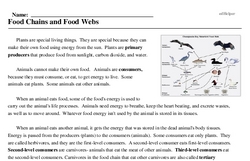Food Chains and Food Webs
Plants are special living things. They are special because they can make their own food using energy from the sun. Plants are primary producers that produce food from sunlight, carbon dioxide, and water.
Animals cannot make their own food. Animals are consumers, because they must consume, or eat, to get energy to live. Some animals eat plants. Some animals eat other animals.
When an animal eats food, some of the food's energy is used to carry out the animal's life processes. Animals need energy to breathe, keep the heart beating, and excrete wastes, as well as to move around. Whatever food energy isn't used by the animal is stored in its tissues.
When an animal eats another animal, it gets the energy that was stored in the dead animal's body tissues. Energy is passed from the producers (plants) to the consumers (animals). Some consumers eat only plants. They are called herbivores, and they are the first-level consumers. A second-level consumer eats first-level consumers. Second-level consumers are carnivores- animals that eat the meat of other animals. Third-level consumers eat the second-level consumers. Carnivores in the food chain that eat other carnivores are also called tertiary consumers (tertiary means third). A food chain shows how food energy is passed along from producers to consumers.




